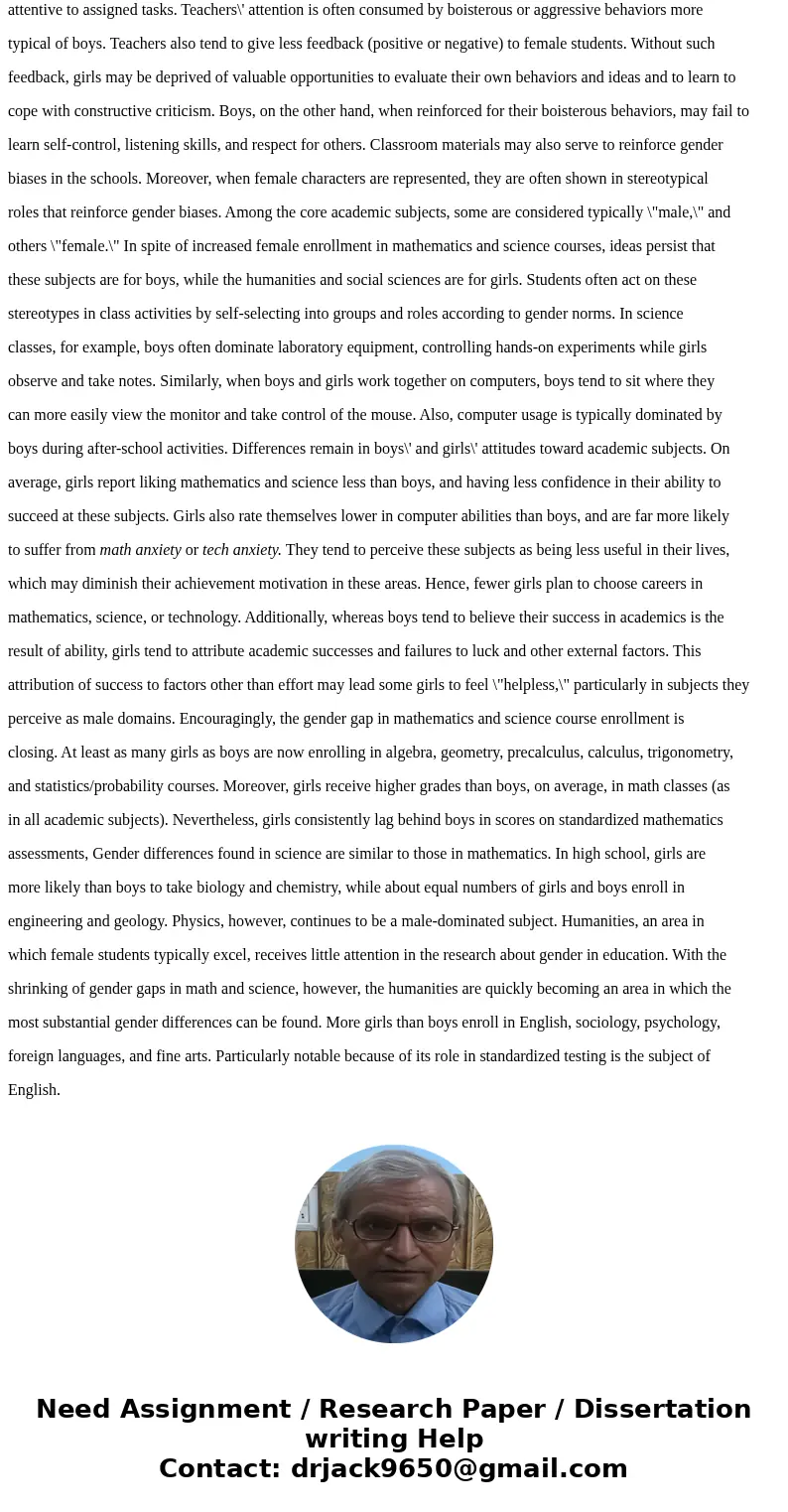Describe and explain the role of 1 Cognitive Processes 2 Ge
Describe and explain the role of
1. Cognitive Processes &
2. Gender and Ethnic Differences
in individual differences of student’s reading skills.
Your assignment should not be less than 300 words
Solution
Cognitive processes
One common stereotype of developmental theory holds that \"stages\" of development must necessarily be
monolithic and uniform across children and tasks. Despite this stereotype cognitive development, including reading,
does not in fact show this simple uniformity.
Most discussions of diversity in developmental sequences emphasize variation with context, but there are
many other factors that produce variation as well. One important factor is the strategy with which a child
approaches a task. A child who uses a different strategy for reading a word is using a different skill and
consequently can be expected to show a didderent developmental sequence. In
reading as in many skills certain strategies produce more rapid learning and more
powerful sills, and others produce less rapid learning and more diffifculties.
For example different strategies in dealing with the relations between visual
graphic and phonological domains will result in different sequences and different degrees of reading skill. Strategy
use can arise from many causes, ranging from specific genetic factors to type of experience with reading. One
individual difference in strategy that has been discussed extensively in the reading literature involves
the phonological domain. A number of investigators have reported that most children with dyslexia or specific
problems with reading show deficiencies in sound-analysis skills. Similar sound analysis difficulties have been
reported in adults with reading problems. A possibility then, is that many children with reading problems will show a
different ordering of their sound analysis skills(assessed by Rhyme recognition and Rhyme production).
Gender and Ethnic Differences
The literature regarding gender in education has focused on areas where girls are underserved,
some have argued that gender equity appeared to pertain to girls only. Near the turn of the new millennium,
however, a few authors brought attention to the education gender gap for boys, showing that the national
phenomenon of male underachievement has been nearly invisible in the gender-equity literature. Gender equity is
not \"for girls only,\" and improvement for one gender should not imply a disadvantage for the other.
Girls and boys appear to have similar types and amounts of opportunities to help them prepare for elementary
school. For example, equal numbers of girls and boys are enrolled in center-based preschool programs and receive
equivalent amounts of literacy activities at home. Preschool girls perform higher on tests of small motor skills than
boys, and they show fewer signs of developmental difficulties in areas such as physical activity, attention, and
speech. Boys in the early grades are more likely to be identified as learning disabled, to be tracked into remedial
and special education classes, to be diagnosed with attention-deficit disorder, to be involved with crimes and
violence on school property, to repeat a grade, and to be suspended from school. Subsequently, boys are more
likely to drop out of school altogether. Girls, on average, receive higher grades than boys in all subjects beginning in
the early grades–a trend that continues throughout middle and secondary school.Aspects of the classroom
environment have been found to foster and/or reinforce gender biases. Often unintentionally, many teachers exhibit
gender biases when interacting with students. For example, teachers generally give more attention to boys than to
girls. Ironically, this is partly caused by the fact that girls tend to be better behaved in the classroom and more
attentive to assigned tasks. Teachers\' attention is often consumed by boisterous or aggressive behaviors more
typical of boys. Teachers also tend to give less feedback (positive or negative) to female students. Without such
feedback, girls may be deprived of valuable opportunities to evaluate their own behaviors and ideas and to learn to
cope with constructive criticism. Boys, on the other hand, when reinforced for their boisterous behaviors, may fail to
learn self-control, listening skills, and respect for others. Classroom materials may also serve to reinforce gender
biases in the schools. Moreover, when female characters are represented, they are often shown in stereotypical
roles that reinforce gender biases. Among the core academic subjects, some are considered typically \"male,\" and
others \"female.\" In spite of increased female enrollment in mathematics and science courses, ideas persist that
these subjects are for boys, while the humanities and social sciences are for girls. Students often act on these
stereotypes in class activities by self-selecting into groups and roles according to gender norms. In science
classes, for example, boys often dominate laboratory equipment, controlling hands-on experiments while girls
observe and take notes. Similarly, when boys and girls work together on computers, boys tend to sit where they
can more easily view the monitor and take control of the mouse. Also, computer usage is typically dominated by
boys during after-school activities. Differences remain in boys\' and girls\' attitudes toward academic subjects. On
average, girls report liking mathematics and science less than boys, and having less confidence in their ability to
succeed at these subjects. Girls also rate themselves lower in computer abilities than boys, and are far more likely
to suffer from math anxiety or tech anxiety. They tend to perceive these subjects as being less useful in their lives,
which may diminish their achievement motivation in these areas. Hence, fewer girls plan to choose careers in
mathematics, science, or technology. Additionally, whereas boys tend to believe their success in academics is the
result of ability, girls tend to attribute academic successes and failures to luck and other external factors. This
attribution of success to factors other than effort may lead some girls to feel \"helpless,\" particularly in subjects they
perceive as male domains. Encouragingly, the gender gap in mathematics and science course enrollment is
closing. At least as many girls as boys are now enrolling in algebra, geometry, precalculus, calculus, trigonometry,
and statistics/probability courses. Moreover, girls receive higher grades than boys, on average, in math classes (as
in all academic subjects). Nevertheless, girls consistently lag behind boys in scores on standardized mathematics
assessments, Gender differences found in science are similar to those in mathematics. In high school, girls are
more likely than boys to take biology and chemistry, while about equal numbers of girls and boys enroll in
engineering and geology. Physics, however, continues to be a male-dominated subject. Humanities, an area in
which female students typically excel, receives little attention in the research about gender in education. With the
shrinking of gender gaps in math and science, however, the humanities are quickly becoming an area in which the
most substantial gender differences can be found. More girls than boys enroll in English, sociology, psychology,
foreign languages, and fine arts. Particularly notable because of its role in standardized testing is the subject of
English.



 Homework Sourse
Homework Sourse